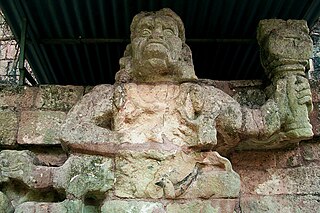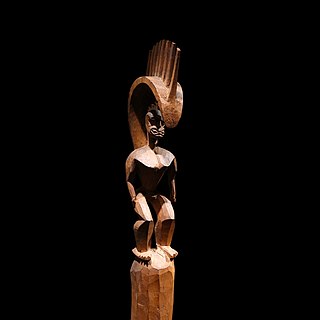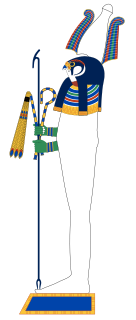 W
WIn Irish mythology, Aengus or Óengus, also called Mac and Óic, is one of the Tuatha Dé Danann and probably originally a god associated with youth, love, summer and poetic inspiration. The son of The Dagda and Boann, Aengus is also known as Macan Óc, and corresponds to the Welsh mythical figure Mabon and the Celtic god Maponos. He plays a central role in five myths reported by medieval Irish texts.
 W
WBes, together with his feminine counterpart Beset, is an ancient Egyptian deity worshipped as a protector of households and, in particular, of mothers, children, and childbirth. Bes later came to be regarded as the defender of everything good and the enemy of all that is bad. Bes may have been a Middle Kingdom import from Nubia or Somalia, and his cult did not become widespread until the beginning of the New Kingdom.
 W
WCao Guojiu, literally Imperial Brother-in-law Cao, is a Chinese mythological figure and one of the Eight Immortals in the Taoist pantheon. His real name was Cao Yi while his courtesy name was Jingxiu, and he was better known to his contemporaries as Cao Jingxiu.
 W
WGanesha (Sanskrit: गणेश, IAST: Gaṇeśa, also known as Ganapati and Vinayaka, is one of the best-known and most worshipped deities in the Hindu pantheon. His image is found throughout India, Nepal, Sri Lanka, Thailand, Indonesia, Singapore, Malaysia, Philippines, and Bangladesh and in countries with large ethnic Indian populations including Fiji, Guyana, Mauritius, and Trinidad and Tobago. Hindu denominations worship him regardless of affiliations. Devotion to Ganesha is widely diffused and extends to Jains and Buddhists.
 W
WGwydion fab Dôn is a magician, hero and trickster of Welsh mythology, appearing most prominently in the Fourth Branch of the Mabinogi, which focuses largely on his relationship with his young nephew, Lleu Llaw Gyffes. He also appears prominently in the Welsh Triads, the Book of Taliesin and the Stanzas of the Graves.
 W
WHan Xiangzi, courtesy name Qingfu or Beizhu, is a Chinese mythological figure and one of the Eight Immortals in the Taoist pantheon. He studied Taoist magical arts under the tutelage of Lü Dongbin, another of the Eight Immortals. Han Xiangzi is often depicted carrying a dizi, so he is also regarded as the patron deity of flutists. He is also believed to be the composer of the Taoist musical piece Tian Hua Yin (天花引).
 W
WAmong the Classic Mayas, the howler monkey god was a major deity of the arts—including music—and a patron of the artisans, especially of the scribes and sculptors. As such, his sphere of influence overlapped with that of the Tonsured Maize God. The monkey patrons—there are often two of them—have been depicted on classical vases in the act of writing books and carving human heads. Together, these two activities may have constituted a metaphor for the creation of mankind, with the book containing the birth signs and the head the life principle or 'soul', an interpretation reinforced by the craftsman titles of the creator gods in the Popol Vuh.
 W
WIn Aztec mythology, Huehuecóyotl [weːweˈkojoːt͡ɬ] is the auspicious Pre-Columbian god of music, dance, mischief, and song. He is the patron of uninhibited sexuality and rules over the day sign in the Aztec calendar named cuetzpallin (lizard) and the fourth trecena Xochitl.
 W
WKokopelli is a fertility deity, usually depicted as a humpbacked flute player, who is venerated by some Native American cultures in the Southwestern United States. Like most fertility deities, Kokopelli presides over both childbirth and agriculture. He is also a trickster god and master braider and represents the spirit of music.
 W
WIn Hawaiian religion, the god Lono is associated with fertility, agriculture, rainfall, music and peace. In one of the many Hawaiian stories of Lono, he is a fertility and music god who descended to Earth on a rainbow to marry Laka. In agricultural and planting traditions, Lono was identified with rain and food plants. He was one of the four gods who existed before the world was created. Lono was also the god of peace. In his honor, the great annual festival of the Makahiki was held. During this period, war and unnecessary work was kapu (forbidden).
 W
WLugh or Lug is one of the most prominent gods in Irish mythology. A member of the Tuatha Dé Danann, Lugh is portrayed as a warrior, a king, a master craftsman and a savior. He is associated with skill and mastery in multiple disciplines, including the arts. He is also associated with oaths, truth and the law, and therefore with rightful kingship. Lugh is linked with the harvest festival of Lughnasadh, which bears his name. His most common epithets are Lámfada [ˈl̪ˠaːwəd̪ˠə] and Samildánach.
 W
WNencatacoa or Nem-catacoa was the god and protector of the mantle makers, artists and festivities in the religion of the Muisca. The Muisca and their confederation were one of the advanced civilizations of the Americas; as much as the Aztec, Mayas and Incas but other than the other three, they did not construct grand architecture. Their gold working however was well-known and respected which made Nencatacoa an important deity and protector.
 W
WNuska was the vizier of the chief Sumerian god Enlil. He is also described as a scribe who records events, and a boatman who takes Enlil to his future wife, Ninlil. His shrine was recorded to be in the Ekur.
 W
WOdin is a widely revered god in Germanic mythology. Norse mythology, the source of most surviving information about him, generally portrays Odin as king of the gods and associates him with wisdom, healing, death, royalty, the gallows, knowledge, war, battle, victory, sorcery, poetry, frenzy, and the runic alphabet, and depicts him as the husband of the goddess Frigg. In wider Germanic mythology and paganism, the god was known in Old English as Wōden, in Old Saxon as Wōdan, in Old Dutch as Wuodan, and in Old High German as Wuotan, all ultimately stemming from the Proto-Germanic theonym *Wōđanaz, meaning 'lord of frenzy', or 'leader of the possessed'.
 W
WIn ancient Greek religion and mythology, Pan is the god of the wild, shepherds and flocks, nature of mountain wilds, rustic music and impromptus, and companion of the nymphs. He has the hindquarters, legs, and horns of a goat, in the same manner as a faun and a satyr. With his homeland in rustic Arcadia, he is also recognized as the god of fields, groves, wooded glens and often affiliated with sex; because of this, Pan is connected to fertility and the season of spring. The word panic ultimately derives from the god's name.
 W
WQuetzalcoatl is a deity in Aztec culture and literature whose name comes from the Nahuatl language and means "Precious serpent" or "Quetzal-feathered Serpent". In the 17th century, Ixtlilxóchitl, a descendant of Aztec royalty and historian of the Nahua people, wrote, "Quetzalcoatl, in its literal sense, means 'serpent of precious feathers', but in the allegorical sense, 'wisest of men'."
 W
WSeker is a falcon god of the Memphite necropolis.
 W
WTork Angegh was an ancient Armenian masculine deity of strength, courage, of manufacturing and the arts. A creature of unnatural strength and power, Tork was considered one of Hayk's great-grandsons and reportedly represented as an unattractive male figure. He is mentioned by Armenian 5th Century historian Movses Khorenatsi and considered one of the significant deities of the Armenian pantheon prior to the time when it came under influence by Iranian and Hellenic religion and mythology. Taken in the context of Proto-Indo-European religions, it is conceivable that an etymological connection with Norse god Thor/Tyr is more than a simple coincidence.
 W
WVäinämöinen is a demigod, hero and the central character in Finnish folklore and the main character in the national epic Kalevala by Elias Lönnrot. Väinämöinen was described as an old and wise man, and he possessed a potent, magical singing voice.
 W
WXōchipilli [ʃu˕ːt͡ʃiˈpiɬːi] is the god of art, games, dance, flowers, and song in Aztec mythology. His name contains the Nahuatl words xōchitl ("flower") and pilli and hence means "flower prince".